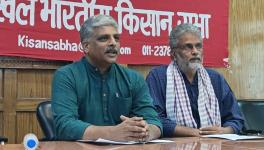Churu Farmers Deprived of Claims Under PM Fasal Bima Yojana
Ramkaran Chaudhary is in a fix about approaching the court to get justice or ending his quest after running from pillar to post to get the insurance claim for his last year’s perished crop.
Chaudhary, a farmer in Rajasthan’s Churu district, is distressed by the looming damage to his gram crop but his immediate concern is to get the insurance claim.
“I sowed gram in 5.5 hectares the previous year and paid a premium of Rs 1,800 under the Pradhan Mantri Fasal Bima Yojana. However, my claim was rejected owing to a clerical mistake by a bank employee,” he tells Newsclick.
“I have two farm plots measuring 5.5 hectares. The bank deducted the premium for both plots but mentioned them as one plot in the papers. The insurance company rejected the claim stating that the amount claimed was more than the plot’s size,” he adds.
When Chaudhary asked the agriculture department to correct the anomaly, he was told that the bank did not mention both plots. “What’s my fault? They have been deducting the premium from my account but not providing relief when I need it most.”
Chaudhary argues that he is a loanee farmer who availed of the Kisan Credit Card and should pay the premium for the Central insurance scheme for farmers even if he does not want to enrol in it.
According to the guidelines mentioned on the scheme’s website, “All farmers who have been sanctioned Seasonal Agricultural Operations loans from Financial Institutions (FIs) (i.e. loanee farmers) for the notified crop(s) season would be covered compulsorily. This provision shall override any decision taken by FIs, including PACS exempting farmers from compulsory coverage of loanee
farmers.”
Chaudhary is also infuriated by the “arbitrariness” in assessing crop loss by insurance companies.
“The insurance company does not seek our opinion while surveying farms. In the neighbouring village of Nakasara, not a single family had a single grain of gram after the massive crop damage. Yet they got no relief with insurance companies citing zero damage,” he alleges adding that he “does not understand their assessment parameters”.
In the previous version of the scheme, Chaudhary says, the “damage was assessed on the basis of moisture and rain data furnished by the meteorological department. If the temperature was 0 degree Celsius, the crop was considered completely perished and claims were duly released”.
“It is complete chaos now,” he says. “If insurance companies get premiums from 100 farmers, they give claims only to a small minority and their profits are swelling.”
As per data furnished by Union agriculture minister Narendra Singh Tomar in reply to a question asked by BJP’s Rajya Sabha member and former Bihar chief minister Sushil Kumar Modi last year, insurance companies minted more than Rs 40,000 crore in profits from 2016-2017 to 2021-22. The data suggest that the companies paid claims worth Rs
11,9,314 crore against accumulated premiums worth Rs 15,9,132 crore.
Sunil Puniya, a farmer in Rajgarh Tehsil, Churu, who has faced the disparity suggests that the state authorities “arbitrarily changed” the damage assessment method when they switched from the crop-cutting method to the satellite imagery system.
“There is complete arbitrariness in assessing crop loss and
farmers are always on the losing side. When the crop loss was 90%, it was shown at 25%. The PM Fasal Bima Yojana guidelines in Rajasthan for the 2021 Kharif season clearly mentioned that the crop-cutting method should be used to assess the loss. Yet the state authorities used satellite imagery,” a frustrated Puniya tells Newsclick.
In the crop-cutting method, according to Puniya, the agriculture supervisor along with other officials from the insurance company and the patwari take random samples of the crop from a patch of 5X5 metres and weigh it to assess if the produce is less than the set standards. Subsequently, a proportionate relief is released.
“Satellite imagery misses it completely,” he argues. “My crop might look intact in the rain from the outside with the grains looking fine but it has perished from the inside. The insurance agent will show us images that the crop was fabulous but we know that it was lost,” he says.
Farmers were also “denied hearing when insurance companies approached state technical committee instead of the district-level monitoring committee,” he alleges.
“Any farmer cannot go to Jaipur to see if his claim was disputed by the insurance company. When blocked the national highway for more than a day in protest, the district administration informed us that the Central authorities had taken note of the irregularities and asked the state government to rectify them but we haven’t gotten any relief,” Puniya further alleges.
Ashok Dhawale, the president of All India Kisan Sabha (AIKS), alleges that the insurance scheme is “the biggest farce of the Narendra Modi government” and the “ultimate objective is corporate profit”.
“There’s a reason why we call it a farce. We saw how insurance companies ran away from their responsibility of paying claims,” he alleges referring to their response when farmers who lost crops during the floods in Maharashtra’s Beed district in October 2020 claimed insurance.
“When farmers affiliated with the All India Kisan Sabha approached an insurance company regarding claims, they were told that they were not eligible for claims as the loss should have been reported within 72 hours,” he alleges.
“The farmers said that all roads were flooded and they also found the insurance company’s office was itself inundated and
locked. When our pleas were rejected, we launched a struggle for claims and met the state agriculture secretary and minister to apprise them of our ordeal. They said that if the insurance company does not pay claims, the state government will not give its share. They received claims after two years,” Dhawale further alleges.
Dhawale adds that the government should do away with innate flaws in the scheme through onsite assessment.
“Insurance companies are employing strategies like remote sensing to deprive farmers of their claims. There should be an onsite inspection to assess the real-time loss,” he suggests.
“Second, companies take samples from a big cluster of villages. Suppose a few villages are hit by drought whereas others are completely fine. Now, the insurance company may choose the unaffected villages to portray that there was no crop damage/loss. Therefore, the unit for assessment should be smaller like a village.”
Get the latest reports & analysis with people's perspective on Protests, movements & deep analytical videos, discussions of the current affairs in your Telegram app. Subscribe to NewsClick's Telegram channel & get Real-Time updates on stories, as they get published on our website.
























